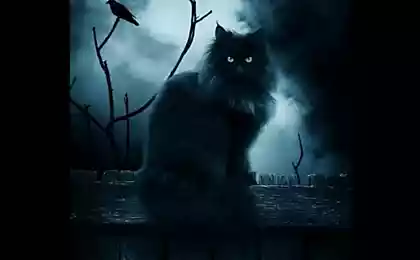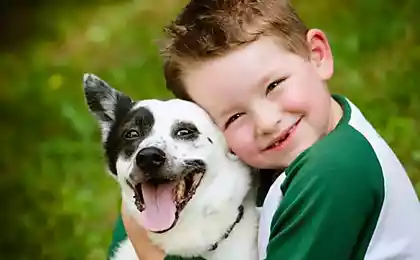1496
11 bizarre species of turtles
Turtle - one of the most ancient breeds of reptiles that exist began about 220 million years ago. They live in the sea and on land, and they have a bony shell that has evolved to protect them from predators. There are about 300 different species of turtles of different shapes and sizes, but some are a little more ... unique than others.
10. Spiny turtle

Spiny turtle - Heosemys spinosa - has amazing armor and lives in south-east Asia. As in many other types of turtles on the barbed turtle hunt as for food, and therefore, as well as because of the destruction of its habitat, its population has fallen sharply in recent years.
Tortoiseshell zubtseobraznoy shaped spines on the edge. Young animals are very sharp thorns, but with age they become more rounded. Spikes deter predators from attacking the young turtles, and they are also a kind of camouflage, masking turtle under fallen leaves. Brown also helps simulate leaves.
9. Chinese myagkopantsirnaya turtle

Chinese myagkopantsirnaya turtle releases urine mouth. This is a strange process that had never observed in any other animal. This unique opportunity to help the turtle survive in salt water, as it does not lose a lot of fluid from the body and does not need constant restore it. If she swallows too much salt water, the poison. Instead, the urine is discharged through the mouth which is then rinsed with water. Only six percent of urine produced by the turtle comes out through the kidneys.
Like most turtles, the Chinese turtle is a delicacy in many parts of Asia. In China, there are more than 1,500 turtle farms that sell more than 90 million turtles a year. Because of its high demand in cooking, this kind of turtle is now added to disappear. These turtles are found in China, Japan, Taiwan, North Vietnam and Russia to the east. They were also introduced in other areas, such as Malaysia, Hawaii, California, and even.
8. Turtle River Mary

Turtle River Mary lives exclusively in the river Mary in Queensland, Australia. Its color can be red, pink, brown or black. Her head is small and the tail is long compared with the whole body, it can grow to a length of almost shell. Under the chin have long projections called tendrils. Females Mary River turtle reach maturity for 25 years, males - 30, that turtle is a very long period.
Turtle frequently emerges from the water to breathe, but it can also receive oxygen and water. Oxygen enters the body through its organs located in its tail. Turtle spends most of its life in the river, allowing algae to grow on her body. It uses algae as a disguise. In the picture algae on the head turtles look like hair, which is why she got the nickname "turtle - punk rocker».
7. Barbed myagkopantsirnaya turtle

Barbed myagkopantsirnaya turtle is common in the US, Canada, and northern Mexico. She has a unique look, round head and flat round shell, covered with black spots. These spots are pronounced in young turtles, but with age, they disappear. Do turtles long thin nose and projections shishkopodobnye front shell.
Sex differences offspring barbed myagkopantsirnoy turtles laid genetically. Most other species of turtles floor depends on the temperature of the sand in which the eggs were postponed.
6. The eastern long-necked turtle

We found in the lakes of eastern Australia by the long-turtle extremely long neck compared with other species, it can grow to the length of the carapace. The neck is so long that the turtle has to draw her into his shell, and not to stick out. This species is also known as the "snake-necked turtle with" because the head and neck resemble a snake. She also has a similar method of hunting, quickly straighten the neck, it affects production.
If there is any threat, turtle releases stinking fluid from their glands. Radius of these precipitates of about one meter (three feet), so all the animals that are close by, fleeing. Most of his life spent on land turtle.
5. gnarled hunchbacked turtle
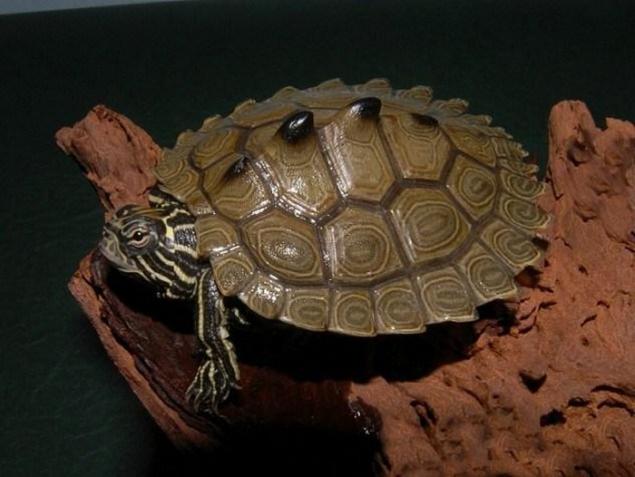
Knobbly hunchbacked Turtle - Graptemys nigrinoda - small water turtle that lives in freshwater rivers Mississippi and Alabama. The most characteristic feature of this turtle is a small number of spines on the carapace, which become less pronounced in adult turtles. The lower part of the shell is covered with beautiful patterns, they tend to light gray or blue. Turtle diet consists mainly of insects, which it collects from the surface of the river.
4. loggerhead turtle
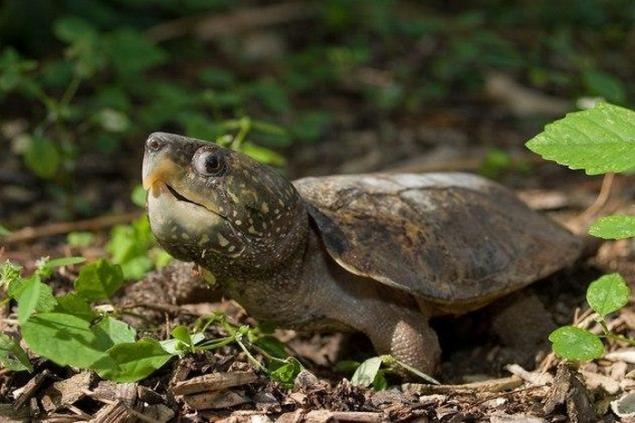
Loggerhead turtle lives in Southeast Asia. A characteristic feature of this species is (you guessed it) a huge head. Her smooth gentle brown shell. Unlike other species of turtles, she can not retract his head into his shell, so she had a bony "hat" to protect the exposed head. Turtle often uses its powerful jaws to defend itself against threats.
Loggerhead turtle often climbs trees and hills, using her big beak, claws and muscular tail to grab various items. They have become an endangered species due to excessive hunting for them. Turtles commonly eaten in Asia, and their catch and sell.
3. "The Tortoise and Piglet»
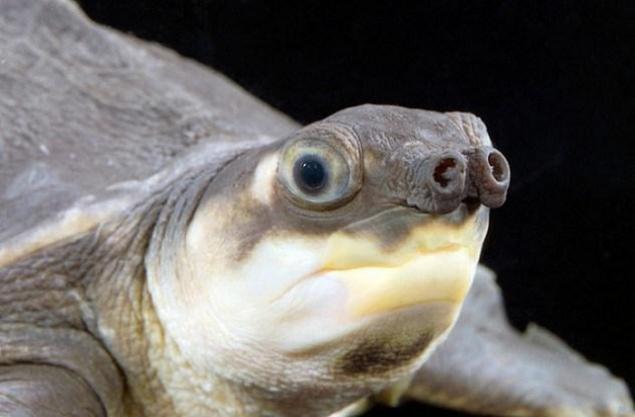
Turtle with a snout is a native of Guinea and Australia. This is the only freshwater turtle that has fins, like sea turtles, but its most prominent feature is the nose that resembles a pig nose. The nose can act as a breathing tube, speaking above the water surface. It is also very sensitive to movements and is used to detect prey in murky water.
Unfortunately, the total number of turtles and Piglet decreased almost doubled in the last 50 years due to smuggling: they are caught in large quantities for the exotic pet trade. Turtle populations are drastically reduced on the island of New Guinea, where they were also harvested for meat. This kind of turtle is the last known species of the family dvuhkogotnyh. Fortunately, Australia and Indonesia are taking steps to preserve this species.
2. Krasnobryuhaya korotkosheyaya turtle

Krasnobryuhaya korotkosheyaya turtle - Emydura subglobosa - resides in Australia and Papua New Guinea. Their shell is orange on the edges and on the bottom of the shell (much brighter young turtles). Color fades when they get older, but the orange markings can be clearly seen in the adult turtles. These turtles spend most of their life in the water, crawling only nest or bask. When she basks in the sun can make the angular motion, because of which she appears tears, they flow in the face and get into the mouth, which she opens and closes (it's very similar to the way a dog does when thirsty).
1. African helmeted turtle

African helmeted turtle lives on the African continent and is widespread from Ghana to Cape Town. This turtle is also found in Madagascar and the Arabian Peninsula. Turtle produces a strong smell of four glands located on the extremities, which is intolerable horses and people. When the females lay eggs, they choose the place and pee in it to soften the earth's surface, thereby relieve themselves digging.
Feeding behavior of African helmeted turtle is also noteworthy. They hunt large prey - pigeons, snakes, turtles other - groups. It is the only species of turtles that hunt in packs.
+ Indian flapshell turtle
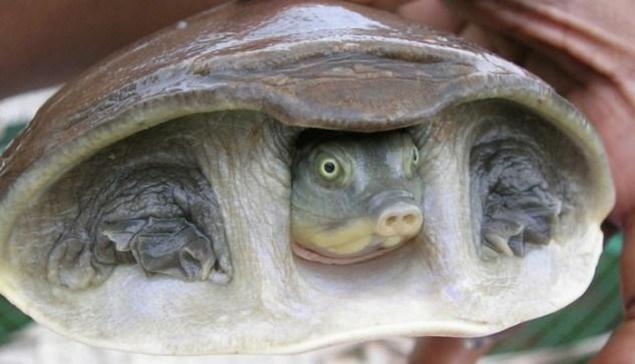
In Lissemys - Lissemys punctata - under the skin of the blade shell available that cover her limbs when they are retracted. It is not known exactly how the blade protects the turtle from predators. This species is found in rivers, lakes and swamps of southern Asia.
Caleb is an author and a site moderator Listverse, he hails from Cornwall, UK. His personal page you can view Twitter (account "strange animal"). You can view his personal account, or contact him by e-mail zdest.
10. Spiny turtle

Spiny turtle - Heosemys spinosa - has amazing armor and lives in south-east Asia. As in many other types of turtles on the barbed turtle hunt as for food, and therefore, as well as because of the destruction of its habitat, its population has fallen sharply in recent years.
Tortoiseshell zubtseobraznoy shaped spines on the edge. Young animals are very sharp thorns, but with age they become more rounded. Spikes deter predators from attacking the young turtles, and they are also a kind of camouflage, masking turtle under fallen leaves. Brown also helps simulate leaves.
9. Chinese myagkopantsirnaya turtle

Chinese myagkopantsirnaya turtle releases urine mouth. This is a strange process that had never observed in any other animal. This unique opportunity to help the turtle survive in salt water, as it does not lose a lot of fluid from the body and does not need constant restore it. If she swallows too much salt water, the poison. Instead, the urine is discharged through the mouth which is then rinsed with water. Only six percent of urine produced by the turtle comes out through the kidneys.
Like most turtles, the Chinese turtle is a delicacy in many parts of Asia. In China, there are more than 1,500 turtle farms that sell more than 90 million turtles a year. Because of its high demand in cooking, this kind of turtle is now added to disappear. These turtles are found in China, Japan, Taiwan, North Vietnam and Russia to the east. They were also introduced in other areas, such as Malaysia, Hawaii, California, and even.
8. Turtle River Mary

Turtle River Mary lives exclusively in the river Mary in Queensland, Australia. Its color can be red, pink, brown or black. Her head is small and the tail is long compared with the whole body, it can grow to a length of almost shell. Under the chin have long projections called tendrils. Females Mary River turtle reach maturity for 25 years, males - 30, that turtle is a very long period.
Turtle frequently emerges from the water to breathe, but it can also receive oxygen and water. Oxygen enters the body through its organs located in its tail. Turtle spends most of its life in the river, allowing algae to grow on her body. It uses algae as a disguise. In the picture algae on the head turtles look like hair, which is why she got the nickname "turtle - punk rocker».
7. Barbed myagkopantsirnaya turtle

Barbed myagkopantsirnaya turtle is common in the US, Canada, and northern Mexico. She has a unique look, round head and flat round shell, covered with black spots. These spots are pronounced in young turtles, but with age, they disappear. Do turtles long thin nose and projections shishkopodobnye front shell.
Sex differences offspring barbed myagkopantsirnoy turtles laid genetically. Most other species of turtles floor depends on the temperature of the sand in which the eggs were postponed.
6. The eastern long-necked turtle

We found in the lakes of eastern Australia by the long-turtle extremely long neck compared with other species, it can grow to the length of the carapace. The neck is so long that the turtle has to draw her into his shell, and not to stick out. This species is also known as the "snake-necked turtle with" because the head and neck resemble a snake. She also has a similar method of hunting, quickly straighten the neck, it affects production.
If there is any threat, turtle releases stinking fluid from their glands. Radius of these precipitates of about one meter (three feet), so all the animals that are close by, fleeing. Most of his life spent on land turtle.
5. gnarled hunchbacked turtle

Knobbly hunchbacked Turtle - Graptemys nigrinoda - small water turtle that lives in freshwater rivers Mississippi and Alabama. The most characteristic feature of this turtle is a small number of spines on the carapace, which become less pronounced in adult turtles. The lower part of the shell is covered with beautiful patterns, they tend to light gray or blue. Turtle diet consists mainly of insects, which it collects from the surface of the river.
4. loggerhead turtle

Loggerhead turtle lives in Southeast Asia. A characteristic feature of this species is (you guessed it) a huge head. Her smooth gentle brown shell. Unlike other species of turtles, she can not retract his head into his shell, so she had a bony "hat" to protect the exposed head. Turtle often uses its powerful jaws to defend itself against threats.
Loggerhead turtle often climbs trees and hills, using her big beak, claws and muscular tail to grab various items. They have become an endangered species due to excessive hunting for them. Turtles commonly eaten in Asia, and their catch and sell.
3. "The Tortoise and Piglet»

Turtle with a snout is a native of Guinea and Australia. This is the only freshwater turtle that has fins, like sea turtles, but its most prominent feature is the nose that resembles a pig nose. The nose can act as a breathing tube, speaking above the water surface. It is also very sensitive to movements and is used to detect prey in murky water.
Unfortunately, the total number of turtles and Piglet decreased almost doubled in the last 50 years due to smuggling: they are caught in large quantities for the exotic pet trade. Turtle populations are drastically reduced on the island of New Guinea, where they were also harvested for meat. This kind of turtle is the last known species of the family dvuhkogotnyh. Fortunately, Australia and Indonesia are taking steps to preserve this species.
2. Krasnobryuhaya korotkosheyaya turtle

Krasnobryuhaya korotkosheyaya turtle - Emydura subglobosa - resides in Australia and Papua New Guinea. Their shell is orange on the edges and on the bottom of the shell (much brighter young turtles). Color fades when they get older, but the orange markings can be clearly seen in the adult turtles. These turtles spend most of their life in the water, crawling only nest or bask. When she basks in the sun can make the angular motion, because of which she appears tears, they flow in the face and get into the mouth, which she opens and closes (it's very similar to the way a dog does when thirsty).
1. African helmeted turtle

African helmeted turtle lives on the African continent and is widespread from Ghana to Cape Town. This turtle is also found in Madagascar and the Arabian Peninsula. Turtle produces a strong smell of four glands located on the extremities, which is intolerable horses and people. When the females lay eggs, they choose the place and pee in it to soften the earth's surface, thereby relieve themselves digging.
Feeding behavior of African helmeted turtle is also noteworthy. They hunt large prey - pigeons, snakes, turtles other - groups. It is the only species of turtles that hunt in packs.
+ Indian flapshell turtle

In Lissemys - Lissemys punctata - under the skin of the blade shell available that cover her limbs when they are retracted. It is not known exactly how the blade protects the turtle from predators. This species is found in rivers, lakes and swamps of southern Asia.
Caleb is an author and a site moderator Listverse, he hails from Cornwall, UK. His personal page you can view Twitter (account "strange animal"). You can view his personal account, or contact him by e-mail zdest.










